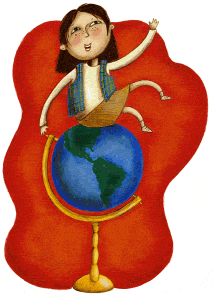 |
The History of Polar Exploration: Why Humans Boldly Go Benchmarks Targeted: I.2.MS.2 Identify and explain historical examples of good character and virtue I.2.MS.3 Describe how events have shaped conditions in various parts of the world I.2.MS.4 Use biographies to show how individuals have influenced history I.3.MS.2 Analyze interpretations to reveal authors' perspectives I.3.MS.3 Show that historical knowledge is tentative and subject to reinterpretation I.4.MS.2 Identify major global decisions in history that set alternate courses of action I.4.MS.4 Select historic decisions and evaluate in light of coredemocratic values Overview: In this lesson, students will become knowledgeable about the history of polar exploration in the arctic by reading the accompanying text, by examining and evaluating previous expeditions, and by learning about WomenQuest's Polar Trek 2001, an arctic trek scheduled for April 2001. The students will research arctic activity using media center resources, including the Internet. They will also learn of the lives of not only men, but also women who have previously traveled to the North Pole. Purpose: The purpose of the lesson is to acquaint students with the history of polar exploration and to help them understand the small, but growing, role of women in arctic journeys. Objectives: The objectives of the lesson should be directly linked to the benchmarks that are the focus of the teacher's direct instruction. The assessment of student performance will then be derived from the objectives. The objectives below include only observable, measurable behavior without specifying the conditions, lower limits, and criteria of quality performance under which that behavior is supposed to take place. The benchmarks that are chosen to receive direct instruction will determine the content of the objectives and the assessment. The objectives below represent a select few of those listed above. As a result of the lesson, students will:
Assessment: How students are assessed during and at the end of the lesson will be determined by which benchmarks receive direct instruction during the lesson. Resources were not available to development an assessment piece for each of the benchmarks noted above. However, a sample assessment has been included. History of Polar Exploration Explorers Curriculum - Middle School Lesson Procedure: Teachers: For middle school grade levels, it may be appropriate to begin the day's lesson with a brief overview of the history of exploration generally. It may start with a discussion of prehistoric migrations that were most certainly preceded by exploration, as well as those closer to the modern era in which explorers discovered or identified new areas for larger populations to move to. Activities - Day One: (1) Assign students to read the accompanying text on the History of Polar Exploration (2) Have students discuss and understand some of the reasons for polar exploration and exploration generally (3) In groups, ask students to identify physical space - on this planet or off - that has yet to be explored and can be reasonably explored. (Encourage them to think of remote islands, parts of the Amazon Basin, and undersea areas, as well as outer space) (4) Ask them to identify what might motivate them or their friends to become members of an expedition (5) Have the students continue the discussion about motivation to explore at home with parents/caregivers. Ask them to turn in a list of reasons the next day Day Two: (6) Give the students a few minutes at the beginning of class to share their lists based on discussions outside class. (7) Assign students to read information about Polar Trek 2001 and the women participating (8) Have the students discuss the emergence of women as expeditioners and adventurers (9) Administer assessment Follow-up Activity: (10) Ask students to write a brief paragraph on the future of exploration based on their knowledge of the history of exploration (11) Have students track the progress of Polar Trek 2001 on the Internet (12) Invite a member of the Polar Trek 2001 team to visit your classroom A Note to Teachers: In conjunction with Polar Trek 2001, an all-women journey to the North Pole sponsored by the WomenQuest Foundation, we are using the event to introduce students to subject matter addressing polar exploration. This is the first in a series of lessons that will examine the history, geography, math and science applications, physical requirements, communication needs, and impact of polar exploration. WomenQuest's journey, scheduled for April 2001, is far less rigorous than those touched on in this lesson - it departs from the 88th parallel -- but it nonetheless provides students the opportunity to talk about the history of polar exploration against the backdrop of a real-time event. The benchmarks targeted for each lesson are taken from the Michigan Department of Education's Social Studies Standards and Working Draft Benchmarks. The word "targeted" means that the teacher will have to deliberately teach the actions students are to take, based on the benchmark, with content from this lesson. Otherwise, the benchmark may not necessarily be addressed by the lesson. Students who successfully complete this lesson, according to the teacher's criteria of quality work and deliberate teaching to the benchmarks noted, will be better prepared to meet the specified benchmarks if formally assessed. Several benchmarks are noted to provide flexibility in instruction. It is not necessary to deliberately teach to every benchmark listed. Please select those benchmarks, which best represent areas where your students need more direct instruction. return to Exploration home page |
|||||
|
|
||||||